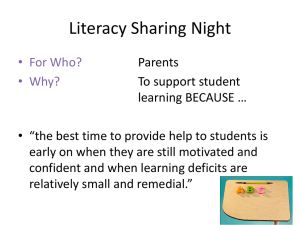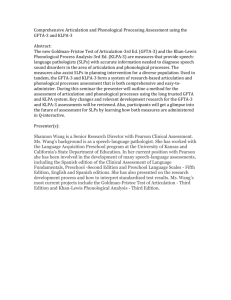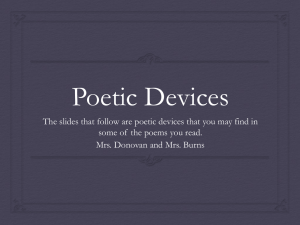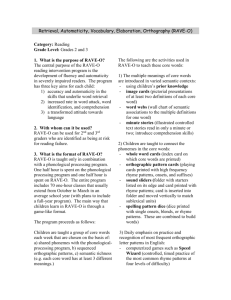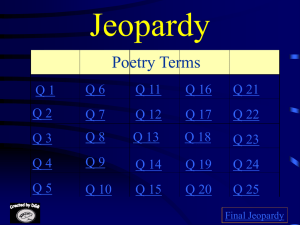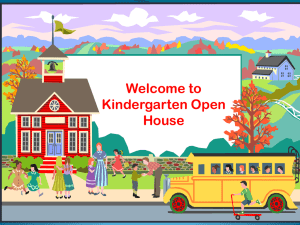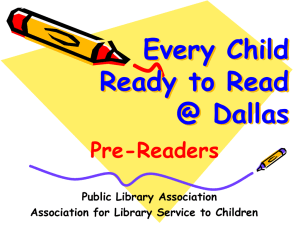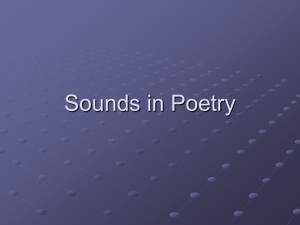Speech And Language Therapists And Education Colleagues
advertisement
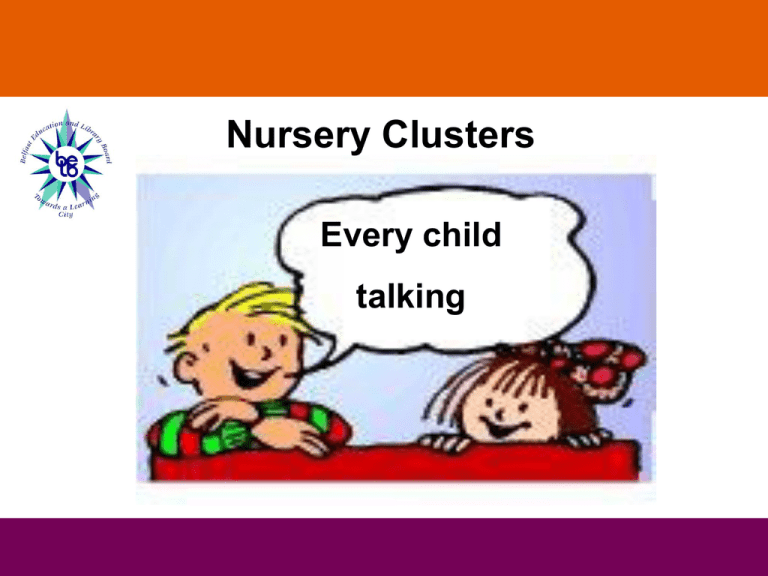
Nursery Clusters Every child talking Supporting speech, language and communication skills Nursery Clusters Cluster 3 Expressive Language Objectives •To share information on the development of : Expressive Language •To explore how we support development of these language skills in Nursery Expressive Language speech vocabulary phonological awareness grammar narrative Vocabulary • Object names (Nouns) • Action names (Verbs) • Adjectives (Adjectives) • Requires semantic (meanings) and phonological (sounds) knowledge • Vocabulary size at age 6 = 10 000 – 14 000 • Learn 6 new words/day from 18mths – 6 yrs • Storage – Word meanings – Sounds in words – Associated information Vocabulary is often used to judge intelligence. "I don't like country music, but I don't mean to denigrate those who do. And for the people who like country music, denigrate means ‘put down’." How do we learn words? • Attention and Listening • Auditory Memory • Must be heard in context (10 – 20 times) • Associations and connections • Must use it Strategies for supporting vocabulary • In context: – – – – Repeat Explain Encourage child to say Use vocabulary wheel Activities for developing vocabulary • Categorising games • Describing games • Guessing games • Odd one out Allow opportunities for lots of repetition of vocabulary and consolidate storage and retrieval Grammar Involves sentence building and grammatical markers including: •Pronouns •Verb tenses •Word order •Plurals •Possessives I drawed a picture hims got my car Modelling Skills required for narrative • Recall of event • Vocabulary • Sequencing • Sentence building • Social skills Phonological awareness • awareness of the sound structure, of language • ability to manipulate the sound structure • a strong predictor of reading success • a listening skill that does not involve print. . Why is Phonological Awareness Important? “The phonological awareness performance of preschool children may be a better predictor of reading and spelling development than variables such as: intelligence scores, age, socio-economic status or vocabulary development” Bryant et al (1989) Steady Beat Children with good mastery of steady beat are much more likely to do well at reading and writing •Maintaining a steady beat •Repeating rhythms using clapping/instruments/voices •Songs with rhythm and rhyme Concept of a word • Real object • Children make up the phrase • Start with two word phrases e.g. big car Syllable Awareness Syllable segmentation: •Fun •Modelled incidentally throughout the year Syllable Syllable The Importance of Rhyme Repetitive patterned language is ideal for tuning a young child’s ears into the sounds of speech Rhyme Hearing rhyme doesn’t come naturally to some children. Lots of repetition is necessary. Rhyme Awareness •Exposure to Rhyme •Concept of Rhyme •Rhyme Completion •Rhyme Judgement •Rhyme Sort •Rhyme Odd One Out •Rhyme Production Speech Articulation The physiological movements involved in modifying airflow, to produce the various speech sounds. Phonology The way sounds are stored and organised in the mind. The relationship between articulation and phonology is complex, both are important in speech production. Articulation The place of articulation is the point of contact, where an obstruction occurs in the vocal tract between an active (moving) articulator (typically some part of the tongue) and a passive (stationary) articulator (typically some part of the mouth). Development of Articulation Articulation skills develop as a child gradually learns to control the movements of the tongue, lips, jaw and soft palate and coordinate these movements with the production of an air stream. By 4, the physical ability to control these movements should be almost 100% except for ‘r’ and ‘th’. Phonology The way sounds are stored and organised in the mind. STORAGE OUTPUT INPUT Phonology All children make predictable pronunciation ‘errors’ when they are learning to talk like adults. These 'errors' are called phonological processes. Phonological processes are a common and predictable part of phonological development often mistaken as simple pronunciation errors. Phonological processes have usually 'gone' by the time a child is five years of age. Examples of Phonological Processes •Reduplication: daddy – dada, water – wawa •Fronting: car – tar, get – det •Stopping: zoo –doo, Jane – dane •Voicing: cup – gup, pear – bear •Final Consonant Deletion: nice – nie, bag -ba my tosin Dane do a nie bat tat Hearing Attention and Listening Modelling Auditory Memory Helping with speech sounds Ensure the child feels communication success Check hearing, listening and auditory memory skills Model - Don’t correct Assist effective storage memory phonological awareness Check if attending SLT Language learning does not happen in isolation, it takes place within meaningful everyday interactions with adults and peers.
